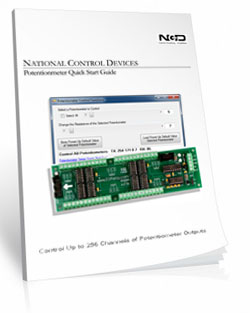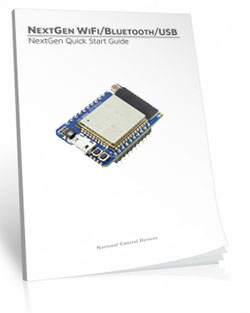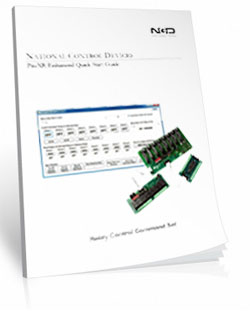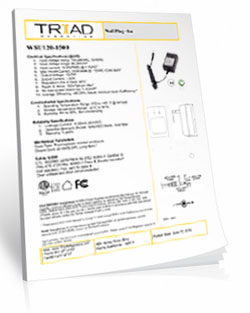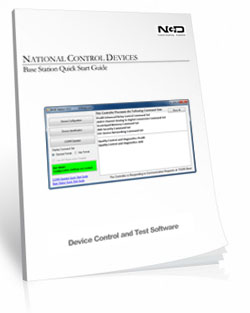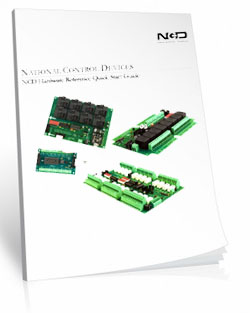8-Channel Programmable Potentiometer with WIFI Interface
ZPOT8PROXR_WIFI
Resistance Output
The ZPOT8ProXR_WIFI Digital Potentiometers have 3 Connections: A, Wiper, and B. When a low value is sent to the controller, the wiper moves closer to A, decreasing the resistance between A and the wiper (increasing the resistance between the wiper and B). When a high value is sent to the controller, the wiper moves closer to B, decreasing the resistance between the wiper and B (increasing the resistance between the wiper and A). It's possible to set the wipers on all outputs individually or simultaneously.NexGen WiFi Communication
The ZPOT8ProXR_WIFI features the NexGen WiFi communications module that modernizes connectivity by combining WiFi, Bluetooth, USB, and MQTT Communications into a single module. The NexGen WiFi module includes firmware that focuses on the most needed features while retaining the flexibility to adapt to just about any application. Using the integrated web page in Soft AP mode, users have the ability to configure the NexGen WiFi module by enabling and disabling features as needed.
8-Channel Programmable Potentiometer with WIFI Interface
ZPOT8PROXR_WIFI- OVERVIEW
- Potentiometer Features
- NexGen INTERFACE
- NexGen SETUP
- ProXR Expansion
- ACCESSORIES
- Data Sheets
USB Potentiometer at a Glance
- 8-Channel Digital Potentiometer
- 256 Taps Per Potentiometer
- Values of 10 kΩ, 50 kΩ and 100 kΩ
- Wiper Current of up to 1mA Per Channel
- Expandable up to 256 POTs w/UXP Expansion Port
- Control Relays Using the XR Expansion Port
- Available in 10K, 50K and 100K Resistance
- Temperature Rating -40° C to 85° C
- Expandable to 256 Potentiometers - Next Generation WiFi
- 2.4GHz WiFi Communications IEEE 802.11 b/g/nr
- TCP, HTTP, Bluetooth, USB, UDP, MQTT
- Security: WPA/WPA2/WPA2-Enterprise and WPS
- Supports DHCP or Static IP
- Soft AP Web Interface for Configuration
- Integrated Web Page for Basic Relay Control
- FCC Certified Bluetooth with 320′ Range
0-5VDC Voltage Range ONLY
Potentiometer boards offer a resistance output, and cannot provide a voltage output of any kind. Integrated potentiometers are limited to applications that operate in the 0 to 5V range. Each potentiometer has a maximum current capacity of 1ma, exceeding these rating will damage the board.
Digital Potentiomer
You've been asking for NCD to bring back their Digital Potentiometer and they heard you! Back in production as a Legacy controller, this device will not become obsolete as long as Parts Remain Available! Based on the MCP42xx0 Series Digital Potentiometers, use a computer to change the resistor values on 8 different programmable resistors with up to 256 taps per potentiometer. Available in Potentiometer values of 10 kΩ, 50 kΩ and 100 kΩ with a wiper current of up to 1mA per channel. Set the Power-Up Default State of the first 32 Potentiometers or read the Power-Up Default State of Each Potentiometer. All other Potentiometers default to a center position for all wipers.Resistance Output
Potentiometers have 3 Connections: A, Wiper, and B. When a low value is sent to the controller, the wiper moves closer to A, decreasing the resistance between A and the wiper (increasing the resistance between the wiper and B). When a high value is sent to the controller, the wiper moves closer to B, decreasing the resistance between the wiper and B (increasing the resistance between the wiper and A). The first 32 channels of wiper values can be set to a power-up default state. It is possible to set the wipers on all outputs individually or simultaneously.Send Commands to Program the Output Resistance
You can send commands to program the output resistance of each individual output, or you program all outputs at the same time. Other commands allow you to set the startup resistance of each output. The ProXR command set allows you to send commands to activate relays, deactivate relays, control all the relays at one time, plus you can send commands that tell a relay to turn on for a few seconds, minutes, or hours. You can assign 16 timers to any of the 256 relays, and set the timers to go off after the duration has expired.Expandable as Your Needs Grow
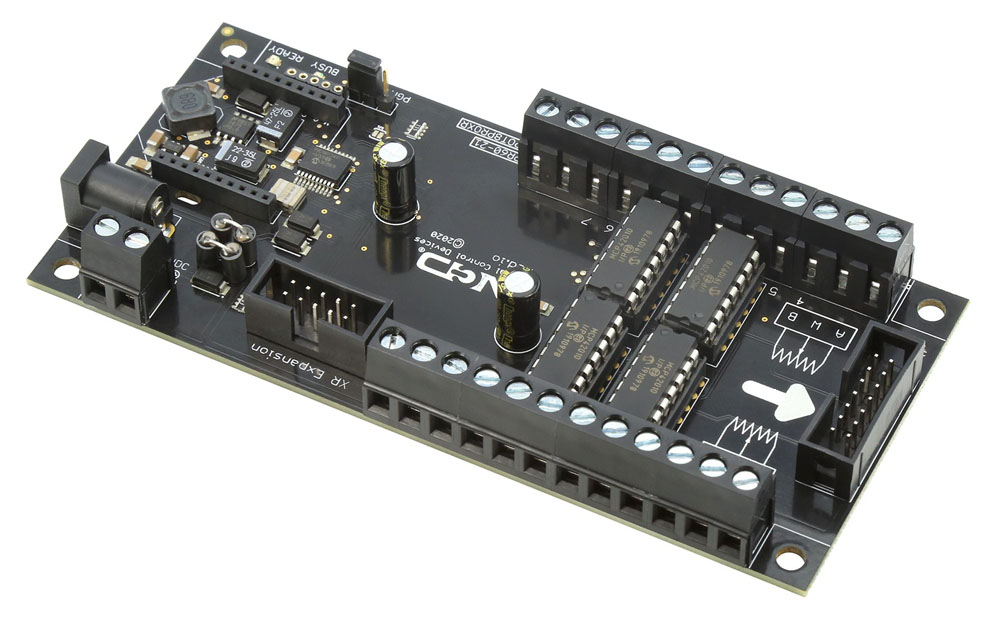 Built on the ProXR Framework, the ProXR Series has a long history of reliability while maintaining an easy learning curve using our Base Station Software as a guide for controlling and using this product. Equipped with a UXP expansion port, add up to 256 Potentiometer Channels by chaining expansions to this main controller board. Equipped with a XR Expansion port, this device is capable of controlling up to 256 relays of various types using XR Series relay controllers. Simply plug in any XR Expansion Relay Controller and you are ready to switch solid state relays, DPDT signal relays, general purpose SPDT relays, and high-power relays. Supports simple relay control commands such as off, on, or toggle functions as well as more complex commands for activating relays using integrated timers.
Built on the ProXR Framework, the ProXR Series has a long history of reliability while maintaining an easy learning curve using our Base Station Software as a guide for controlling and using this product. Equipped with a UXP expansion port, add up to 256 Potentiometer Channels by chaining expansions to this main controller board. Equipped with a XR Expansion port, this device is capable of controlling up to 256 relays of various types using XR Series relay controllers. Simply plug in any XR Expansion Relay Controller and you are ready to switch solid state relays, DPDT signal relays, general purpose SPDT relays, and high-power relays. Supports simple relay control commands such as off, on, or toggle functions as well as more complex commands for activating relays using integrated timers.
New Version Shipping
Beginning Late 2020, NCD made some updates to this product to make it better with increased component count while maintaining the same functionality and footprint. The New Rev G2 Series adds a better power supply circuit to improve noise immunity while providing increased power availability. We als changed the color of the circuit board to Black and updated branding to ncd.io with updated logos.Legacy Product
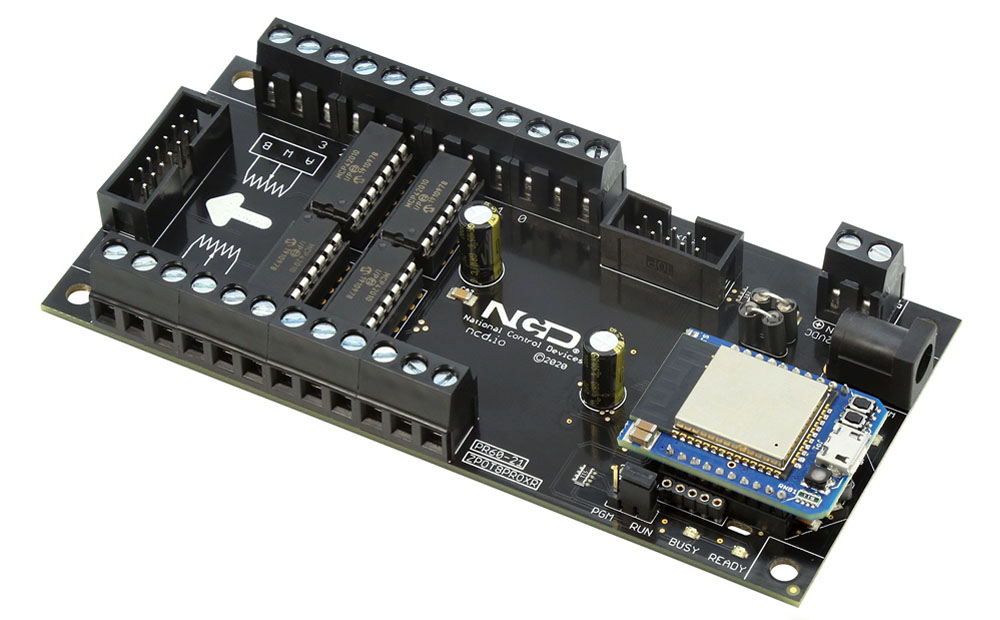 This is now a Legacy Product, which means it will never go obsolete as long as critical parts are still available to us. Built with their new high-speed pick and place assembly line, they can complete the surface mount assembly process at a rate of several thousand units per day with the potential to scale to any volume you could imagine, so you never need to worry about supply quantities or supply chain problems.
This is now a Legacy Product, which means it will never go obsolete as long as critical parts are still available to us. Built with their new high-speed pick and place assembly line, they can complete the surface mount assembly process at a rate of several thousand units per day with the potential to scale to any volume you could imagine, so you never need to worry about supply quantities or supply chain problems.
More Interfaces Available
This controller features a modular communications interface, capable of accepting USB, RS-232, Ethernet, WiFi, Bluetooth, communication modules. Control potentiometers directly from cloud platforms such as Amazon AWS or MQTT when working with our WiFi Bluetooth USB Communications module. Control Potentiometers using a USB Interface and a Virtual COM Port communications when using our USB interface. Control Potentiometers over WiFi or Ethernet by opening a TCP socket to port 2101 and start sending commands (as shown in Base Station).Base Station Compatible
Use Base Station software to quickly learn the command structure for potentiometer control using a simple Point and Click interface that supports all communication technologies.Resistance Output
Please keep in mind; our POT series controllers offer a resistance output, and cannot provide a voltage output of any kind without additional electronics. The potentiometers are limited to applications that operate in the 0 to 5V range. Each potentiometer has a maximum current capacity of 1ma. Exceeding these rating will immediately damage the controller.Connections
Potentiometers have 3 Connections: A, Wiper, and B. When a low value is sent to the controller, the wiper moves closer to A, decreasing the resistance between A and the wiper (increasing the resistance between the wiper and B). When a high value is sent to the controller, the wiper moves closer to B, decreasing the resistance between the wiper and B (increasing the resistance between the wiper and A). The first 48 channels of wiper values can be set to a power-up default state. It is possible to set the wipers on all outputs individually or simultaneously.Output Resistance
Send commands to program the output resistance of each individual output, or you program all outputs at the same time. Other commands allow you to set the startup resistance of each output. The ProXR command set allows you to send commands to activate relays, deactivate relays, control all the relays at one time, plus you can send commands that tell a relay to turn on for a few seconds, minutes, or hours. You can assign 16 timers to any of the 256 relays, and set the timers to go off after the duration has expired. The complete command set can be found in the ProXR Quick Start Guide located in the Data Sheets tab above.This Board is RoHS Compliant
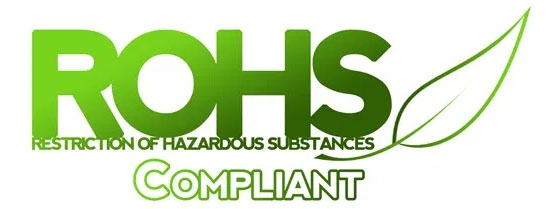 This board is led free and RoHS Compliant. If your requirements are for RoHS compliant parts this board is manufactured with RoHS compliant led free parts and solder.
This board is led free and RoHS Compliant. If your requirements are for RoHS compliant parts this board is manufactured with RoHS compliant led free parts and solder.
Precautions
This is an expansion module and must be connected to a compatible board to work. This board will NOT work on it's own. Please keep in mind; our POT series controllers offer a resistance output, and cannot provide a voltage output of any kind without additional electronics. Integrated potentiometers are limited to applications that operate in the 0 to 5V range. Each potentiometer has a maximum current capacity of 1ma. Exceeding these rating will immediately damage the board.Wi-Fi, Bluetooth, USB or Web Page Control
Control this board using standard WiFi TCP/IP communications or use the integrated Bluetooth for simple wireless computer to device interface using a wireless virtual COM port. Easy setup using a integrated Web Page User Interface for all Configuration settings.
WiFi Relay
WiFi Relay Control
The NexGen WiFi is NCD's second generation WiFi communications module that modernizes connectivity by combining WiFi, Bluetooth, USB, and MQTT Communications into a single module. The NexGen WiFi module includes firmware that focuses on the most needed features while retaining the flexibility to adapt to just about any application. Using the integrated web page in Soft AP mode, users have the ability to configure the NexGen WiFi module by enabling and disabling features as needed.Three Interface Options, ONE Module!
WiFi Communications
The NexGen WiFi module supports TCP communications, essentially converting TCP data to serial data for device control. Configure network setting such as DHCP or a Static IP address. Configure the network Port number and serial baud rates for connectivity to the NCD device using the integrated web page while in Soft AP mode. The Soft AP mode is compatible with web browsers on mobile devices such as Android or IOs devices, as well as laptops and desktop computers with integrated WiFi communications. Once configuration data is complete, exit the Soft AP mode and use the optional integrated web page to control basic relay control functions via the integrated web page (non-secure) or send data to the WiFi module using some of the optional protocols supported below.Bluetooth Communications
The NexGen WiFi module also supports Bluetooth connectivity via the Bluetooth Classic protocol. By implementing the Bluetooth Serial Port Profile, NCD products will appear to your computer as a standard COM port, making it easy to communicate wireless data via Bluetooth between the PC and the device. Users have the ability to set the Bluetooth discovery name and PIN number via the integrated Web Page using Soft AP mode.USB Communications
We also built the NexGen WiFi module to include a USB port, which may be used for direct USB communications to the device. Simply configure the USB Virtual COM Port parameters using the Soft AP mode and the integrated web page. The NexGen WiFi module will mount as a COM port on your computer, allowing access to the device through serial communications.WiFi Communication Protocols
MQTT
The NexGen module supports very basic MQTT usage. It can be configured to connect to an MQTT broker using no auth or basic auth (username/password). Testing of this functionality was done using beebotte.com. The NexGen WiFi module implements one subscribe topic and one publish topic. It listens for control commands over the subscribe topic and sends command responses to the publish topic, which may be user defined using the integrated web page in Soft AP mode.HTTP
Using WiFi communications, it's also possible to send commands to NCD devices using the HTTP API. For example, to activate a relay on a NCD device, Simply send the HTTP command to the IP address 192.168.1.10 in any web browser using the following command structure: 192.168.1.10/sendCommand?data:[254,108,1]Web Socket
Use a Web Socket to send commands to a NCD device. Users can establish a web socket to the board via ws://{controller IP}/ws. This web socket expects command bytes to be sent in the form of a JSON array, for example “[254,108,1]” (activate the first relay on a NCD relay board). Note this array should be sent in TEXT/String format as shown with quotes. Any data received from the host board will be sent to the web socket in the same format (JSON Array).Discovery and Diagnostics
UDP Broadcast
The NexGen module broadcasts a UDP packet on ports 55555 and 13000 for network discovery purposes. This allows discovery of the the NexGen WiFi module in Base Station and may be used for network discovery in your own software applications.RGB Status LED
The integrated RGB LED displays communications and status information. Diagnose connectivity status or communication problems with different flashing color patterns to indicate module bootup, wifi connectivity, and configuration modes.Taralist NTP Time Sync
This option enables Network Time Protocol time syncing of the Taralist Real Time clock. When enabled, once per day the NexGen module will sync it’s time with time.google.com, then it will update the on board Taralist Real Time clock. Note that this feature is only valid on Taralist series relay controllers and will only work if WiFi is enabled and internet connectivity is present on the connected WiFi Network.Compatibility
For use with 2.4GHz WiFi Networks ONLY. This module does NOT support 5GHz WiFi.PLEASE CONSULT WITH NCD STAFF PRIOR TO RETROFITTING OLDER DEVICES WITH THIS MODULE!
ONLY NEWLY PURCHASED CONTROLLERS ARE COMPATIBLE WITH THIS MODULE!
In general, this WiFi module works with Fusion series controllers regardless of version. However, this module is NOT COMPATIBLE with older relay boards that you may want to retrofit with WiFi communications. This module requires more power than older devices are capable of supplying. This device is fully compatible with any “G2” board revision, such as boards marked with Rev G2A, G2B, G2C, etc. G2 boards are typically black in color with the exception of Taralist controllers, which are also black in color but NOT equipped with G2 revision markings (and not compatible). If G2 is not marked on the board revision and you are not using a Fusion series controller, this module is NOT compatible. Newly purchased controllers will include a power supply upgrade, allowing compatibility. A service charge to upgrade the power supply on older devices may apply when retrofitting this module.
WiFi Bluetooth USB 3 in 1 Module with MQTT Support
Control NCD devices using standard WiFi TCP/IP communications or use the integrated Bluetooth for simple wireless computer to device interface using a wireless virtual COM port. Use the USB port for control over a virtual COM port for easy connectivity. Integrated web server allows control of select NCD relay controllers using a built-in non-secure web page. This is a low-cost solution that lets you try different solutions with easy setup using a integrated Web Page User Interface for all Configuration settings. Connect to a MQTT Server over WiFi for remote operation over the internet.Configure The Features Needed
Using the integrated web page in Soft AP mode, users have the ability to configure the NexGen WiFi module by enabling and disabling features as needed.
NexGen Module Setup
The NexGen module implements all the same functionality from our previously supplied WiFi, Bluetooth and USB modules but adds additional functionality including a simple web interface for configuration, Bluetooth interface, USB interface, we built in web interface for rudimentary control of select relay products, and MQTT compatibility. We will now cover the configuration of the module.Configuring the NexGen module
To configure a new NexGen module make sure it is installed in a Host board(Relay controller or other product) and it’s LED is flashing Blue. A Blue flashing LED indicates it is in configuration mode. In this mode the module will appear as a WiFi Access point and should show up as an available WiFi network on your computer called NCD_WiFi. Connect to the NCD_WiFi network and enter NCDBeast as the password.Your computer may now automatically pop up a browser window where you can configure the module. If not simply open your web browser and enter 172.217.28.1
You should now see the Configuration Web Interface. We will now cover those options.
WiFi
Here we will cover the WiFi options section of configuration. These are configuration options for associating the WiFi module with your WiFi network. Note that the NexGen module will scan for networks on initial power up and these will be displayed. If you have a hidden network(does not broadcast an SSID) please contact support.Enabled
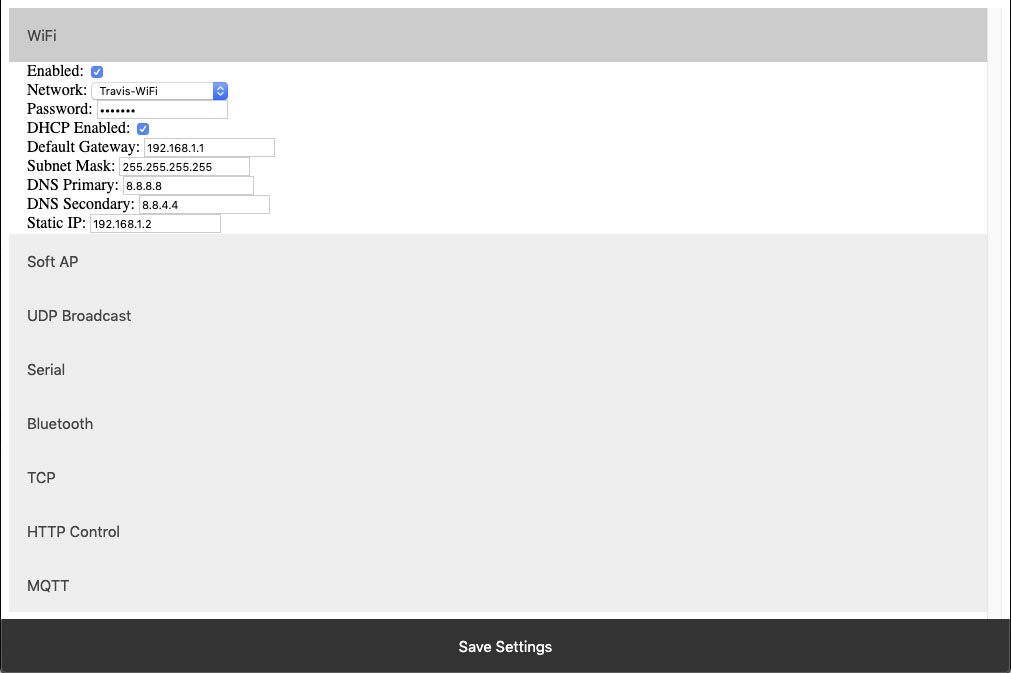 This setting configures whether or not the module should attempt to associate with a WiFi Network.
This setting configures whether or not the module should attempt to associate with a WiFi Network.
Network
This Setting indicates the SSID of the network the module should associate with on power up.Password
This Setting indicates the password which should be used to associate with the network configured through the Network setting.DHCP Enabled
This setting indicates whether the NexGen module should obtain an IP address from a DHCP managed router or if it should use following static IP address settings. Checked indicates to utilize DHCP(Recommended for most applications).Default Gateway
This setting indicates the default gateway the module should communicate through(IP of router). This setting is only applicable if DHCP is not checked.Subnet Mask:
This setting indicates the subnet mask which should be utilized on the network. This setting is only applicable if DHCP is not checked.DNS Primary
This setting indicates the default DNS server to utilize for internet connection to host URLs. This setting is only applicable if DHCP is not checked. If DHCP is checked the default DNS server of the network router will be used.DNS Secondary
This setting indicates the backup DNS server to utilize for internet connection to host URLs. This setting is only applicable if DHCP is not checked. If DHCP is checked the backup DNS server of the network router will be used.Static IP
This setting indicates the Static IP address the NexGen module should utilize once connected to the host network. This setting is only applicable if DHCP is not checked.Soft AP
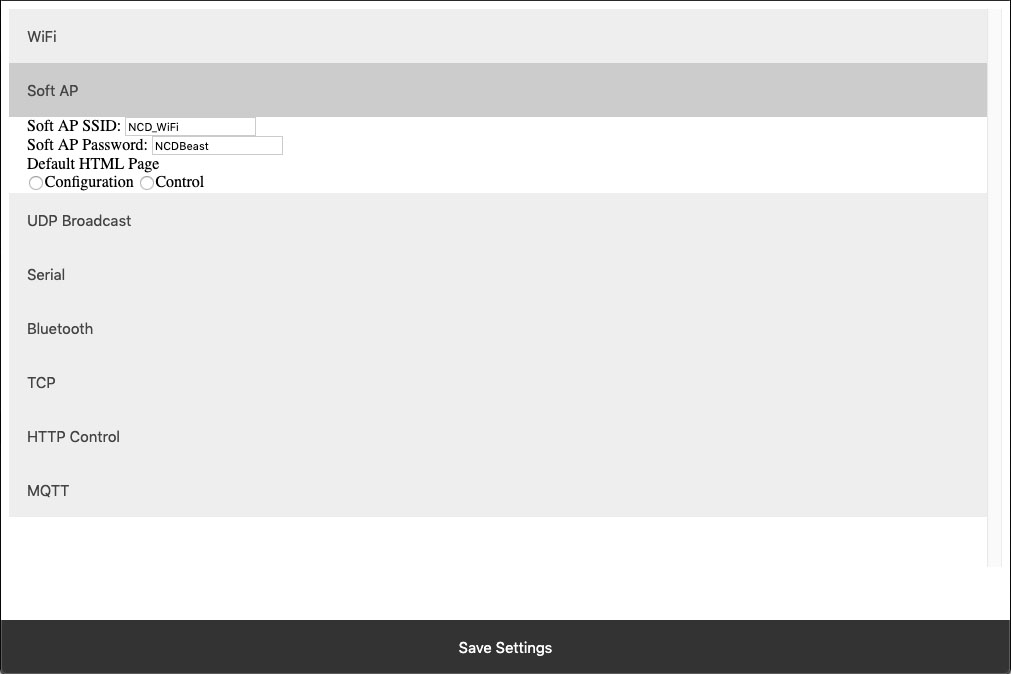 In configuration mode the NexGen module is broadcasts and SSID which devices can connect to. This Soft AP is configurable. It is possible to change the broadcast SSID network name, the password for authenticating, and the default web interface which should be displayed to the user upon initial connection. We will cover those settings here.
In configuration mode the NexGen module is broadcasts and SSID which devices can connect to. This Soft AP is configurable. It is possible to change the broadcast SSID network name, the password for authenticating, and the default web interface which should be displayed to the user upon initial connection. We will cover those settings here.
Soft AP SSID
The SSID the NexGen Module should broadcast while in configuration mode.Soft AP Password
The authentication password required for associating with the NexGen Module’s network.Default HTML Page
Some devices support captive gateways. This setting determines the web interface to display to the user through the captive portal upon initial connection.UDP Broadcast
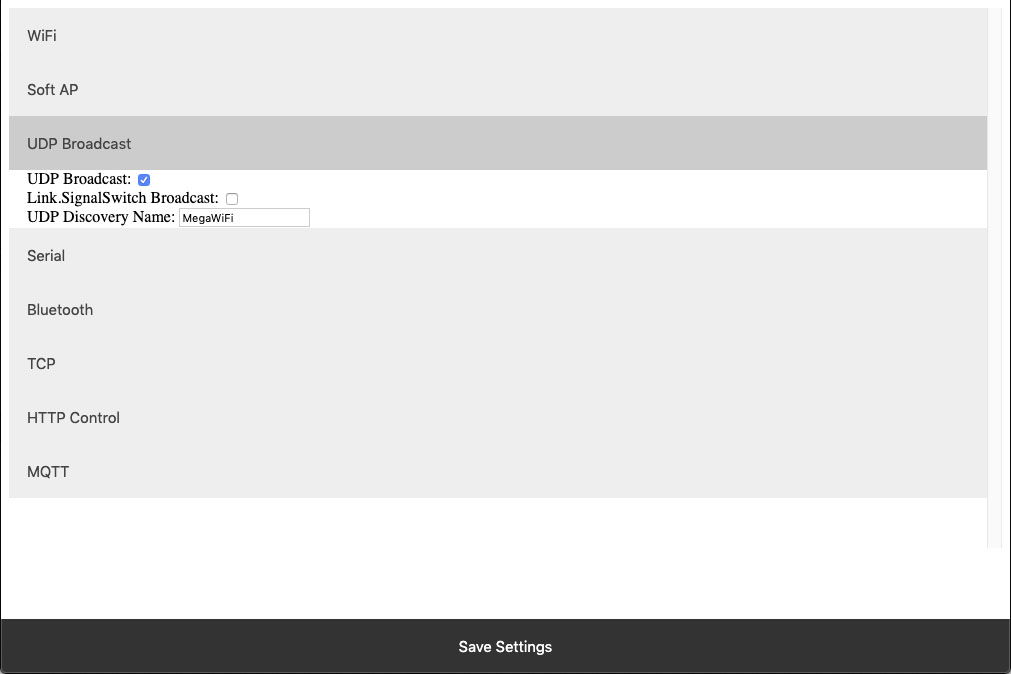 The NexGen module broadcasts a UDP packet on ports 55555 and 13000 for network discovery purposes.  These settings enable this broadcast, forward the broadcast to link.signalswitch.com and alter the name in the discovery packet.
The NexGen module broadcasts a UDP packet on ports 55555 and 13000 for network discovery purposes.  These settings enable this broadcast, forward the broadcast to link.signalswitch.com and alter the name in the discovery packet.
UDP Broadcast
This setting indicates whether or not the WiFi module should send out a network discovery UDP packet on interval.Link.SignalSwitch Broadcast
This setting indicates whether or not the WiFi module should send a discovery packet to link.signalswitch.com on interval or not.UDP Discovery Name
This setting configures the Name field to be send in UDP broadcast packets. This can be used to differentiate multiple devices on the same network.Serial
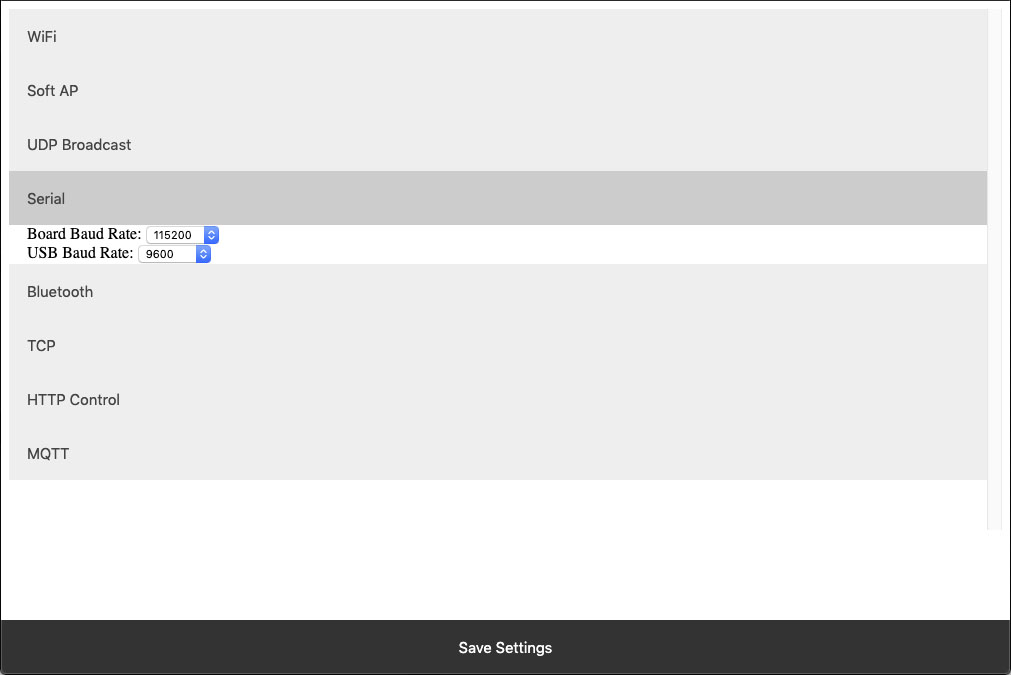 The WiFi module technically has two serial interfaces.  One which communicates through the USB port on the module and a second that communicates to the host board.  These settings apply to those ports.  Keep in mind most Host boards manufactured by NCD have a default baud rate of 115200.
The WiFi module technically has two serial interfaces.  One which communicates through the USB port on the module and a second that communicates to the host board.  These settings apply to those ports.  Keep in mind most Host boards manufactured by NCD have a default baud rate of 115200.
Board Baud Rate
Baud rate of the NexGen module’s serial interface connected to the Host board. Most NCD boards have a default baud rate of 115200. This setting must match the baud rate of the host board.USB Baud Rate
The baud rate for WiFi module’s USB connection. Software connected to the board via USB must match this baud rate.Bluetooth
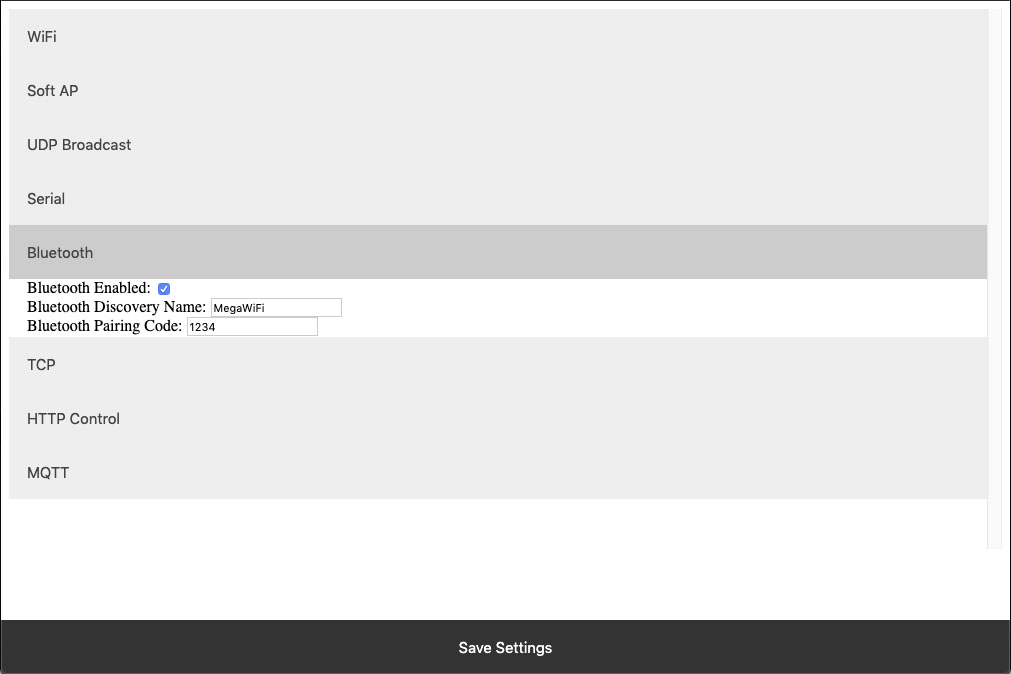 The NexGen module supports Bluetooth connectivity via the Bluetooth Classic protocol. It implements the functionality of a Bluetooth Serial Port Profile device(SPP). It does not implement Bluetooth 4.0 or LE functionality and thus is not compatible with all devices such as iOS.
The NexGen module supports Bluetooth connectivity via the Bluetooth Classic protocol. It implements the functionality of a Bluetooth Serial Port Profile device(SPP). It does not implement Bluetooth 4.0 or LE functionality and thus is not compatible with all devices such as iOS. Bluetooth Enabled
This setting indicates whether or not the NexGen Module should implement bluetooth connectivity.Bluetooth Discovery Name
This is the name which will appear in Bluetooth device scans.Bluetooth Pairing Code
Pairing code required for Bluetooth pairing with the device.TCP
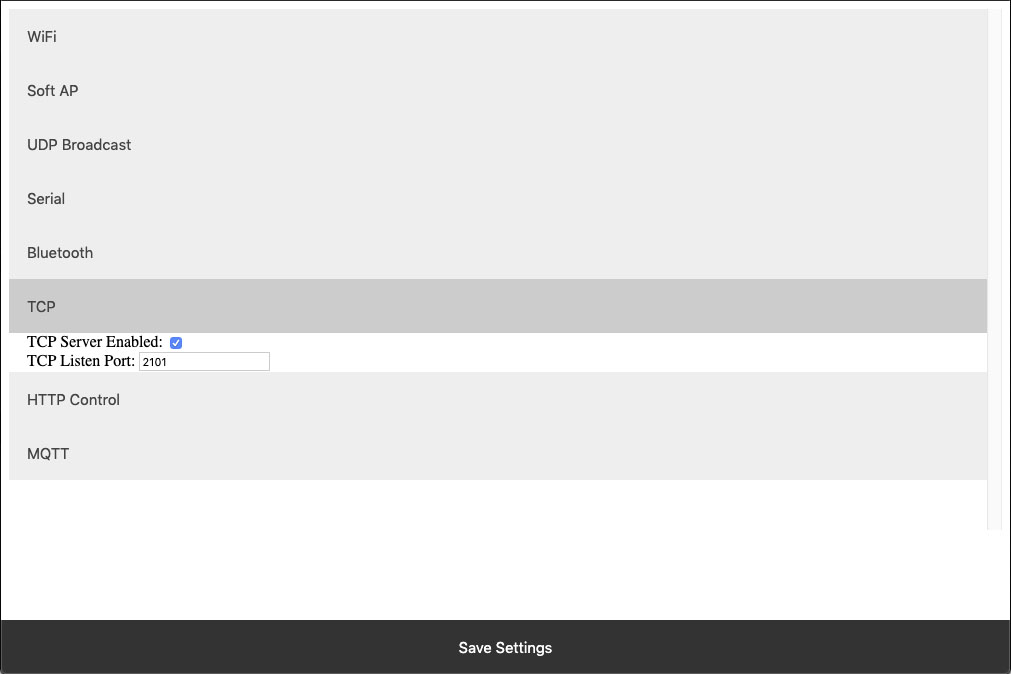 The NexGen module implements the functionality of a TCP server. In this implementation the module opens a socket which clients(software) can connect too. These settings configure this TCP Server functionality.
The NexGen module implements the functionality of a TCP server. In this implementation the module opens a socket which clients(software) can connect too. These settings configure this TCP Server functionality.
TCP Server Enabled
Whether or not to allow TCP clients to connect.TCP Listen Port
The port on which to listen and allow for TCP Client connections.HTTP Control
The NexGen module supports a rudimentary web interface for manually turning relays on and off. This interface only supports ProXR, ProXR Lite, Fusion, and Taralist relay controllers with 8 or fewer relays. This interface is available at {device IP address}/Control.HTTP Control Enabled
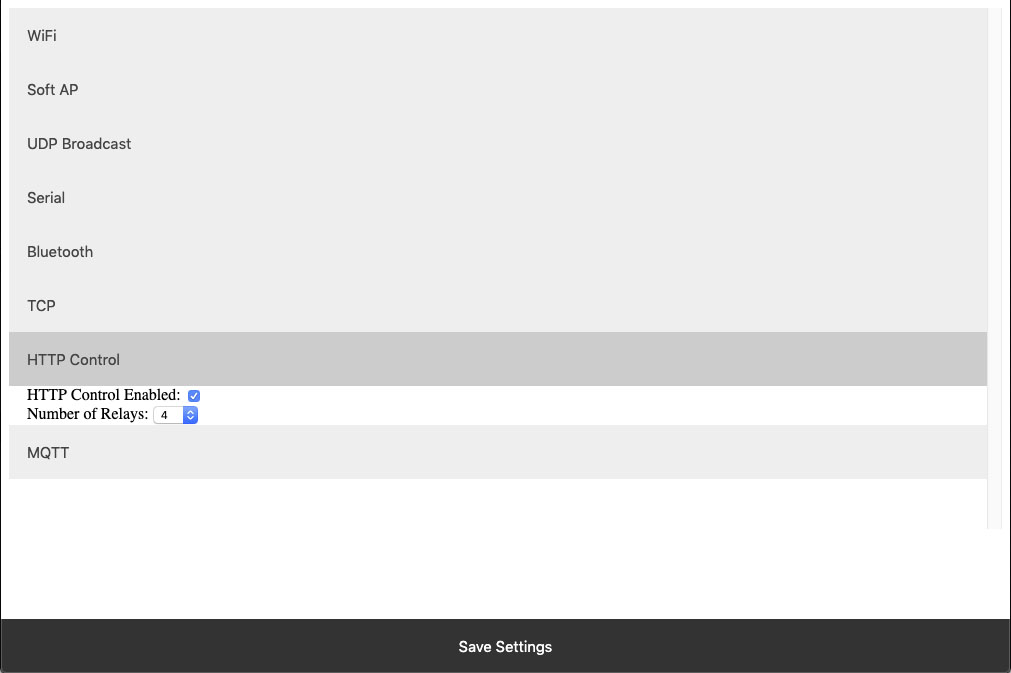 Whether or not to display the HTTP control interface. Select this option if you want to activated the built-in web page to control the relay. Below select how many relays you have on the board, compatible on boards with up to 8 relays installed.
Whether or not to display the HTTP control interface. Select this option if you want to activated the built-in web page to control the relay. Below select how many relays you have on the board, compatible on boards with up to 8 relays installed. Number of Relays
This setting determines the number of relay control sets to display on the control interface. Match this to the number of relays on the board. This ferature is only compatible with boards with 8 relays or less.MQTT
The NexGen module supports very basic MQTT usage. It can be configured to connect to an MQTT broker using no auth or basic auth(username/password). Testing of this functionality was done using beebotte.comThe module only implements one subscribe topic and one publish topic. It listens for control commands over the subscribe topic and sends command responses to the publish topic. Commands should be published to the subscribe topic in a JSON packet. The JSON packet must contain one key value pair with a key of sendCommand and the value for that pair must be a JSON array of command bytes. Example: {“sendCommand”:[254,108,1]}. The WiFi module will publish data received from the host board to the Publish topic. This Publish payload will contain a JSON packet. The format of the packet is a single key value pair with the key of data and the value will be an array of bytes. Example: {“data”:[170,1,85,1]}
MQTT Enabled
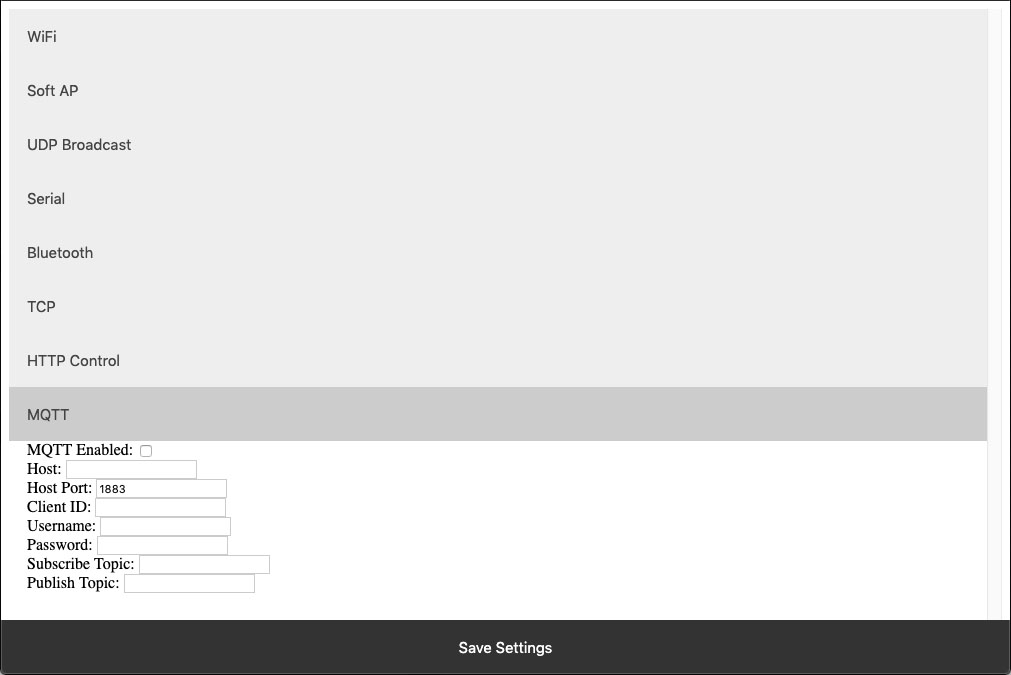 Whether or not to implement MQTT functionality and establish connection to an MQTT broker on boot.
Whether or not to implement MQTT functionality and establish connection to an MQTT broker on boot.
HOST
The Host URL for The MQTT broker.Host Port
The port on which to connect to The MQTT broker.Client ID
The Client ID to use for The MQTT connection.Username
The user name to use for basic authentication with The MQTT broker.Password
The password to use for basic authentication with The MQTT broker.Subscribe Topic
The Topic to subscribe to for host board control commandsPublish Topic
The Topic which to publish data to when data is received from the Host board.HTTP API
The NexGen module supports HTTP GET requests for sending commands to the host board. There are a few different end points for the HTTP Get requests:/relayCount
- A Get request to this end point will return the number of relays on the board(this is configured under Number of relays setting under HTTP Control. - Example: 192.168.1.10/relayCount/relayON
- A GET request to this end point will turn the specified relay on. This GET request requires one arg with the key relay and the value of the relay which to control(valid range for relay number is 1-256) - The board should respond to this GET request with an 85. - Example: 192.168.1.10/relayON?relay=1/relayOFF
- A GET request to this end point will turn the specified relay off. This GET request requires one arg with the key relay and the value of the relay which to control(valid range for relay number is 1-256) - The board should respond to this GET request with an 85. - Example: 192.168.1.10/relayOFF?relay=1/sendCommand
- A GET request to this end point allows the user to send any command to the board they wish. This GET request requires one arg with the key of data and a value of an array of bytes which to send to the host board. - Once the host board has processed the command this GET request will respond with the data returned from the host board. - Example: 192.168.1.10/sendCommand?data:[254,108,1]Web Socket
The NexGen module supports web sockets. Users can establish a web socket to the board via ws://{controller IP}/wsThis web socket expects command bytes to be sent in the form of a JSON array, for example “[254,108,1]”. Note this array should be sent in TEXT/String format as shown with quotes.
Any data received from the host board will be sent to the web socket in the same format (JSON Array).
RGB status LED
The NexGen module has an RGB status LED which is used to indicate the current state of the module to the user visually. Possible statuses are:Flashing Green
The module is running normally but no connections to it have been established.Solid Green
The module is running normally and a connection has been established with the board via software. This will happen when a TCP socket is connected to the board.Flashing Blue
Module is in configuration mode and should appear as a network in WiFi Scans.Flashing Yellow<
Module is booting.Orange Flash
The LED will flash Orange any time data is received over any connection (USB, TCP, Bluetooth, MQTT, etc).Flashing Red
Indicates the module is unable to connect to the WiFi network.Taralist
Taralist NTP Sync Enabled
This option enables Network Time Protocol time syncing of the Taralist Real Time clock. When enabled, once per day the NexGen module will sync it’s time with time.google.com, then it will update the on board Taralist Real Time clock. Note that this feature is only valid on Taralist series relay controllers and will only work if WiFi is enabled and internet connectivity is present on the connected WiFi Network.
UTC Timezone Offset
This setting determines the timezone for NTP clock syncing. Set it to your particular timezone’s UTC offset not factoring in DST. For instance Central Standard Time’s UTC offset is -6, Eastern Standard Time is -5, etc.
Enable Daylight Savings Time
When enabled the controller will offset it’s clock during Daylight savings time.
Viewing the NexGen Module’s NTP time and the on board Taralist Real Time Clock Time.
After Taralist settings have been entered and WiFi settings have been entered and saved to the NexGen module it should connect to your WiFi network and the RGB LED should be flashing green indicating everything is functional. On a computer on the same network as the controller open a web browser and enter the controller’s IP address followed by /Taralist for example: 192.168.0.2/Taralist. The returned HTML page will display both the NTP clock time and the on board Taralist real time clock time. This time is updated nearly once per second. If everything looks valid go ahead and close the page, Taralist is now fully functional. Note do not leave this page open as it taxes the processor to update the web page once per second.
Taralist NTP Sync Enabled
This option enables Network Time Protocol time syncing of the Taralist Real Time clock. When enabled, once per day the NexGen module will sync it’s time with time.google.com, then it will update the on board Taralist Real Time clock. Note that this feature is only valid on Taralist series relay controllers and will only work if WiFi is enabled and internet connectivity is present on the connected WiFi Network.UTC Timezone Offset
This setting determines the timezone for NTP clock syncing. Set it to your particular timezone’s UTC offset not factoring in DST. For instance Central Standard Time’s UTC offset is -6, Eastern Standard Time is -5, etc.Enable Daylight Savings Time
When enabled the controller will offset it’s clock during Daylight savings time.Viewing the NexGen Module’s NTP time and the on board Taralist Real Time Clock Time.
After Taralist settings have been entered and WiFi settings have been entered and saved to the NexGen module it should connect to your WiFi network and the RGB LED should be flashing green indicating everything is functional. On a computer on the same network as the controller open a web browser and enter the controller’s IP address followed by /Taralist for example: 192.168.0.2/Taralist. The returned HTML page will display both the NTP clock time and the on board Taralist real time clock time. This time is updated nearly once per second. If everything looks valid go ahead and close the page, Taralist is now fully functional. Note do not leave this page open as it taxes the processor to update the web page once per second.ProXR Expansion Board
This Expansion Board plugs into the XR Expansion Port on any ProXR or Taralist Board to add more relays. Expansion boards can be daisy chained together to add up to 256 relays as needed.
The XR Expansion Port
Add Relays as Your Needs Grow
ProXR Controllers were built with relay expansion in mind. The XR Expansion Port is used to add banks of external relays to a ProXR or Taralist board equipped with a XR Expansion port. The ProXR and Taralist boards are fitted with an XR Expansion Port where you can add expansion boards. Expansion boards can be added until you reach 256 total relays. As you continue to chain expansion boards onto an XR expansion port, the total number of available relay banks will increase. Add expansion boards as needed in the future, whenever you require more relays simply order another expansion board.Linking XR Expansion Boards Together
XR Expansion Boards consist of a XR Input and XR Output Connector. Simply connect the XR Output of your ProXR Board to the XR Input located on the relay expansion board. Chaining more relays is easy. Simply connect the XR Output of your ProXR expansion board to the XR Input of your next expansion board. Mix and Match different relay types as your application requires. A 6″ expansion cable is included with the expansion board. It's important to keep the cabling as short as possible. Not all users will be able to expand to 256 total relays, as it all depends on the installation, the amount of electrical interference, and the overall cable length. For best compatibility, the total length of the ProXR controller and all of the expansions and cabling should not exceed 1 or 2 meters.Will Not Operate Independently
This Expansion Board gets it's commands from the main ProXR or Taralist board and will not operate independently. This board MUST be plugged into a ProXR or Taralist board to operate and will not function on it's own.SPDT Relay Installed
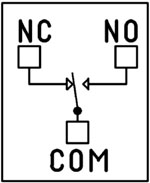 This device has SPDT relays installed. SPDT Single Pole Double Throw Relays have three connections - Common, Normally Open, and Normally Closed. When the relay is off, the common is connected to the normally closed connection of the relay. When the relay coil is energized, the Common swings to the Normally Open Connection of the Relay. You can wire the device you are switching to either the Normally Open or the Normally Closed position using screw terminal connections. The maximum guage wire the terminal can handle is 14 ga but we have used up to 12 ga solid core for several applications with no issues.
This device has SPDT relays installed. SPDT Single Pole Double Throw Relays have three connections - Common, Normally Open, and Normally Closed. When the relay is off, the common is connected to the normally closed connection of the relay. When the relay coil is energized, the Common swings to the Normally Open Connection of the Relay. You can wire the device you are switching to either the Normally Open or the Normally Closed position using screw terminal connections. The maximum guage wire the terminal can handle is 14 ga but we have used up to 12 ga solid core for several applications with no issues.
Mix & Match
Expansion boards do not need to be the same relay amperage as the main board or other expansion boards. Mix &anp; match expansion board to get the exact amperage for your switching needs.Essential Power Requirements
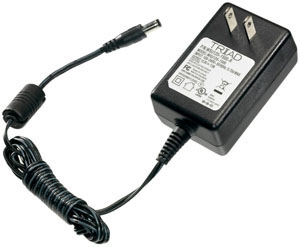 This and all expansion boards require 12 VDC to operate. We offer a wall-wart type power supply at checkout if you need to plug this into a 110 wall outlet. Applying Good clean power to the board is essential for the operation of the board. Without good steady clean power from a regulated power supply the board simply will not function correctly. The PWR12 US power supply is a 120VAC to 12VDC 1.25A 60Hz regulated power supply and it plugs into the barrel connector on the board. The output connector is a 2.1mm I.D. x 5.5mm O.D. x 9.5mm Female R/A barrel connector. We also carry an international power supply with interchangeable adapters for international customers. Learn More
This and all expansion boards require 12 VDC to operate. We offer a wall-wart type power supply at checkout if you need to plug this into a 110 wall outlet. Applying Good clean power to the board is essential for the operation of the board. Without good steady clean power from a regulated power supply the board simply will not function correctly. The PWR12 US power supply is a 120VAC to 12VDC 1.25A 60Hz regulated power supply and it plugs into the barrel connector on the board. The output connector is a 2.1mm I.D. x 5.5mm O.D. x 9.5mm Female R/A barrel connector. We also carry an international power supply with interchangeable adapters for international customers. Learn More
Maximum Relay Rating Notes
ProXR is capable of expanding to an absolute maximum of 256 Relays. In some cases, it may not be possible to control all 256 relays, particularly in applications where high noise levels may be involved. Experimentation may be required, as it is not possible for us to guarantee all users will be able to utilize all 256 relays in every application. Noise tends to accumulate when several expansions are connected together. For best results, the XR expansion cables must be as short as possible.This Board is RoHS Compliant
 This board is led free and RoHS Compliant. If your requirements are for RoHS compliant parts this board is manufactured with RoHS compliant led free parts and solder.
This board is led free and RoHS Compliant. If your requirements are for RoHS compliant parts this board is manufactured with RoHS compliant led free parts and solder.
2-Million Cycles
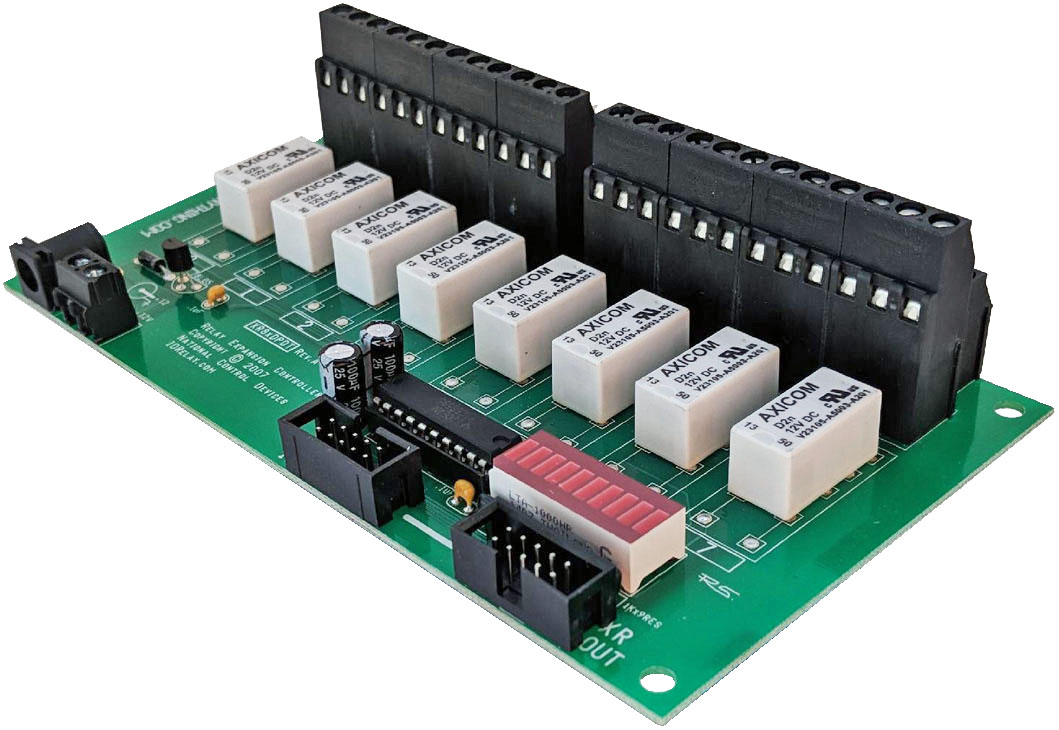 XR Expansion Boards are designed for long life just as the ProXR boards, you should expect to get years of service from expansion board and literally 2-million cycles from the relays on board. With a 5-year warranty and a money back guarantee add more relay anytime the need arises!
XR Expansion Boards are designed for long life just as the ProXR boards, you should expect to get years of service from expansion board and literally 2-million cycles from the relays on board. With a 5-year warranty and a money back guarantee add more relay anytime the need arises! 5-Year Warranty/Money Back Guarantee
ProXR Lite series controllers are guaranteed against manufacturing and functionality defects for a full 5 years! Not to mention a 30-day money back guarantee! If for any reason you are not happy with a relay purchased from Relay Pros, simply return it within 30 days and we will give you your money back! Controllers that are damaged by our customers will not of course be warranted under any circumstances.Relay Expansion Videos
Accessories
Power Supply Available
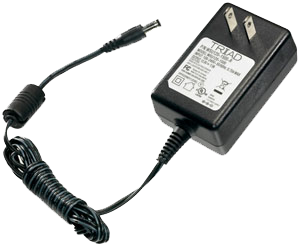 Reliable Power Means
Reliable Power MeansReliable Switching
The PWR12 is regulated power supply providing clean power necessary for the performance of these boards. The PWR12 US power supply is a 120VAC to 12VDC 1.25A 60Hz regulated power supply and it plugs into the barrel connector on the board. The output connector is a 2.1mm I.D. x 5.5mm O.D. x 9.5mm R/A barrel connector.


